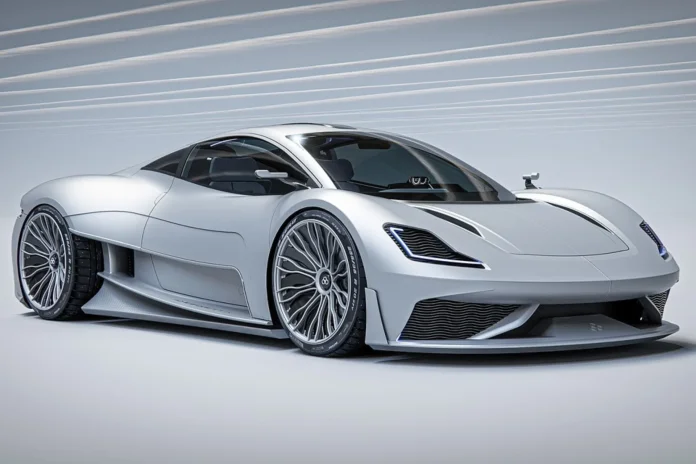The automotive industry will see a marvelous transformation driven by technological advancements, shifting customer preferences, and upgrading regulatory landscapes. As per the analysis, from 2025 to 2027, many automotive trends will reshape the future of the Auto industry. As we all see, the industry is not just upgrading—it’s being redefined. From electric mobility and autonomous driving to data-driven manufacturing and subscription-based models, automakers are now tech companies as much as they are transportation providers. Let’s have a deep look at the top 10 automatic industry trends to watch during this period.
Rise of Software-Defined Vehicles (SDVs)
Software-defined vehicles have revolutionized the automotive industry by incorporating critical functions like steering, brakes, and other important features into software platforms. The shift will allow new updates, tailored features, and updated safety measures. SDV market is going to reach 7.6 million units in 2025 where North America is commanding a share of 43%. Major technology providers like NVIDIA.com and Intel have a great role in this transformation.
OEMs like Mercedes-Benz and GM invest heavily in SDV architectures, often partnering with tech firms. For instance, Qualcomm’s Snapdragon Ride Flex SoC is designed specifically for SDVs. According to McKinsey, by 2030, software could account for 30% of vehicle value, up from just 10% in 2020.
Advancements in Autonomous Driving
Autonomous vehicle (AV) technology continues its rise to the SAE autonomy scale. Most mainstream automakers now offer Level 2+ autonomy, where the car can manage driving tasks under certain conditions, but a human must remain engaged. By 2025–2027, we are expecting more vehicles to offer Level 3 capabilities, especially in luxury and fleet segments.
Companies like Waymo, Cruise, and Tesla are already field-testing self-driving taxis and trucks. However, full autonomy (Level 5) is still a longer-term goal due to regulatory and technological challenges. Nonetheless, by 2027, urban areas could see fully autonomous shuttles and delivery vehicles in service.
Integration of 5G and Vehicle-to-Everything (V2X) Communication
The advent of 5G networks has unlocked new potential in-vehicle communication. Through Vehicle-to-Everything (V2X), cars can now interact with each other, infrastructure (like traffic lights), pedestrians, and the cloud. This enables enhanced situational awareness and quicker decision-making for both drivers and autonomous systems.
A Deloitte study suggests that by 2026, over 70% of new vehicles will have embedded 5G capability. V2X plays a key role in smart city integration, enabling smoother traffic flow and emergency response.
Shift toward Mobility-as-a-Service (MaaS)
Traditional car ownership is no longer the default choice, especially for urban dwellers and younger generations. Mobility-as-a-Service (MaaS) platforms bundle various transport services—ride-sharing, car rentals, e-scooters, and even public transit—into a single digital offering.
Automakers are now offering subscription models, where users can pay monthly fees for access to vehicles or features (e.g., heated seats, advanced navigation). Companies like Stellantis and BMW have begun monetizing features post-sale, generating recurring revenue streams.
According to Statista, the global MaaS market is projected to reach $523 billion by 2027, growing at a CAGR of 32%. This shift requires automakers to think like tech platforms, focusing more on UX and less on just horsepower.
Emphasis on Sustainability and Circular Economy
Climate change and ESG (environmental, social, governance) goals are pushing automakers to re-consider their entire value chains. Automakers are now preferring low-carbon manufacturing, sustainable materials, and ethical sourcing of critical minerals like cobalt and lithium.
For example, Volvo aims to be climate-neutral by 2040, and BMW has committed to using 50% recycled materials in its vehicles by 2030. From battery recycling programs to carbon capture initiatives, the circular economy is becoming central to corporate strategies.
Some manufacturers are even exploring vehicle-to-grid (V2G) technologies, allowing EVs to return excess energy to the power grid, thus reducing environmental strain during peak hours.
Advancements in Hydrogen Fuel Cell Technology
Though EVs are leading the headlines, hydrogen fuel cells are gaining ground—especially for commercial, long-haul, and heavy-duty vehicles where battery weight and recharging time are constraints.
Toyota, Hyundai, and Nikola Motors are heavily investing in hydrogen infrastructure. A report from Allied Market Research forecasts that the hydrogen vehicle market will surpass $42 billion by 2030, with an increasing share in the logistics and municipal sectors.
Hydrogen also holds potential in marine and rail transportation, making it a complementary solution in the clean mobility ecosystem.
In practice, imagine your vehicle warning you of a car braking hard two blocks ahead or automatically adjusting speed based on real-time traffic light changes. This connectivity will also improve fleet management, logistics, and insurance models based on real-time risk data.
Cybersecurity in the Automotive Sector
As vehicles can get connected, they also become vulnerable to cyber threats. Hackers can potentially access sensitive user data, hijack vehicle functions, or exploit OTA systems.
To combat this, global regulations are emerging. Notably, UNECE WP.29 regulations (UNR155 and UNR156) require automakers to have cybersecurity management systems and software update protocols in place. These will be mandatory in many regions by 2026.
Cybersecurity startups focusing on automotive, such as Upstream Security and Karamba, are seeing increased investment and partnerships with OEMs.
Advancements in Automotive Semiconductors
The 2020–2022 chip shortage exposed the auto industry’s dependence on semiconductors. As vehicles become digital platforms, demand for high-performance chips—from central processors to LiDAR modules—continues to soar.
Next-generation chips, especially those based on silicon carbide (SiC) and gallium nitride (GaN), offer better efficiency and thermal performance than traditional silicon. These are crucial for fast-charging EVs and power electronics in autonomous systems.
GlobalFoundries, Bosch, and TSMC are ramping up automotive chip production, while companies like Tesla are designing their own chips in-house to optimize performance.
Reshaping of Global Trade Policies
As geopolitical tensions rise and supply chains evolve, automakers are adapting to new trade environments and automotive trends. The U.S. Inflation Reduction Act, for instance, incentivizes domestic production of EVs and batteries, requiring manufacturers to source materials locally to qualify for tax credits.
This is pushing OEMs to restructure global production networks, often creating regional supply chains to reduce dependency on volatile trade routes. These shifts will reshape where vehicles and components are made, impacting cost structures and innovation pipelines.
Reintroduction of Physical Controls in Vehicle Design
After years of touchscreens replacing traditional buttons, there’s growing recognition that minimalist interiors can sometimes compromise safety. Studies have shown that touch interfaces often require more driver attention than tactile buttons, delaying reaction time.
Starting in 2026, EuroNCAP will award better safety scores to vehicles that retain physical buttons for key functions like hazard lights, defrosters, and headlights. OEMs like Mazda and Volkswagen are already reintroducing knobs and switches for a safer, more intuitive driving experience.
From smart, connected systems to alternative powertrains and mobility models, the automotive industry is at a crossroads. The trends from 2025 to 2027 will not only define the future of vehicles but also how we live, move, and interact with our environments. As technology, policy, and culture converge, those automakers who adapt quickly and strategically will lead the road ahead.



